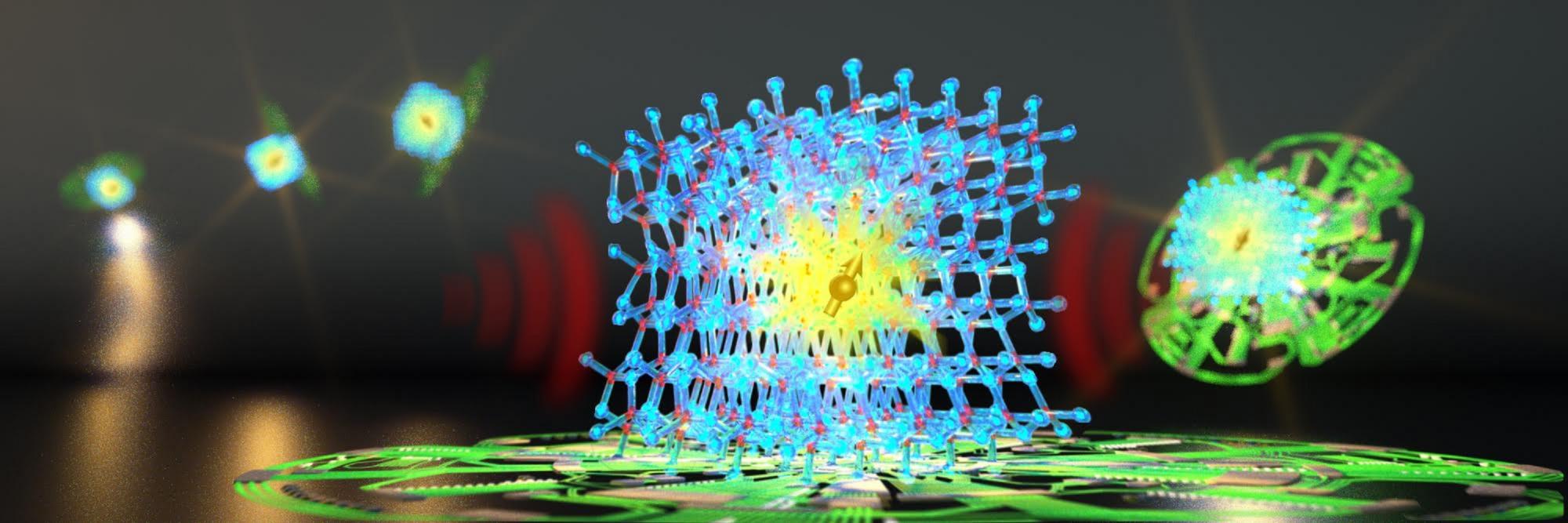 by Benjamin Recchie
by Benjamin Recchie
Molecular engineering has the promise of giving us materials made to order—substances with very specific properties needed to accomplish specific goals. For an example of how this “bottom-up” process works, take quantum computing—and specifically, take a research project on materials for quantum computing by Hosung Seo and Marco Govoni, both postdoctoral scholars in the Institute for Molecular Engineering, and Giulia Galli, the Liew Family Professor in Molecular Engineering.
The basis of ordinary computing is the bit, which can be in a state representing either a zero or a one. However, quantum computing is based on the quantum bit, or qubit. Through the counterintuitive nature of quantum mechanics, a qubit can represent both a zero and a one simultaneously. This property could allow a quantum computer to perform certain kinds of large-scale calculations much faster than a classical computer, even solving some problems that have traditionally been considered unsolvable.
Quantum computers are still in their infancy, in part because of the conditions needed to maintain a qubit. Many researchers have tried to build quantum computers by using ultracold atoms held in a vacuum as qubits, which requires a complex and costly experimental setup. Such a system is adequate for a proof of concept, says Seo, but to find wider applications, it’s critical to find materials that can hold a qubit under less extreme conditions. Furthermore, it should be made of material that’s cheap and easy enough to work with that it could be used in mass production; Govoni says that while diamond has some promise for holding qubits, its cost makes it impractical.
The goal of the Galli group’s study was to use simulations to eliminate likely dead ends so the experimentalists could focus their attention on a likely candidate. The researchers built a model of a material in a simulation, atom by atom, and then tested its suitability. “It’s definitely cheaper than doing an experiment,” says Govoni.
In this case, the experimentalists the Galli group were working with asked them to explore aluminum nitride (AlN)—specifically, to see whether defects in the crystalline structure of the material could be used to hold a qubit. To do so, they used open-source software first to examine the structural and thermodynamic properties of defects in AlN. They then used the WEST code (developed by the Galli group) to accurately predict electronic structures, such as excitations, in the system.
The researchers used Midway and resources at the National Energy Research Scientific Computing Center at Lawrence Berkeley National Laboratory to perform their initial work, then moved their project to the more powerful Mira supercomputer at Argonne National Laboratory. RCC consultant Jonathan Skone also helped them to optimize the productivity of their software.
They found the defect they were looking for in the AlN—a missing nitrogen atom in a certain charge state—but there was a problem. The defect had spin (a quantum measure of angular momentum) equal to zero, and the experimentalists were looking for a defect with a spin greater than 1. However, Seo reasoned that putting the material under strain might do the trick. They modified their simulation model to incorporate strain, and sure enough, it predicted a defect with spin under those conditions.
Seo’s simulations are only the first step. The researchers need to evaluate AlN’s other properties for suitability, and then the experimentalists they work with will need to examine it in the lab. Only if it passes these tests can engineers seriously begin to design quantum devices. But just as molecular engineering is taking technology in directions that were science fiction less than a generation ago, simulations are taking engineering in new directions as well.